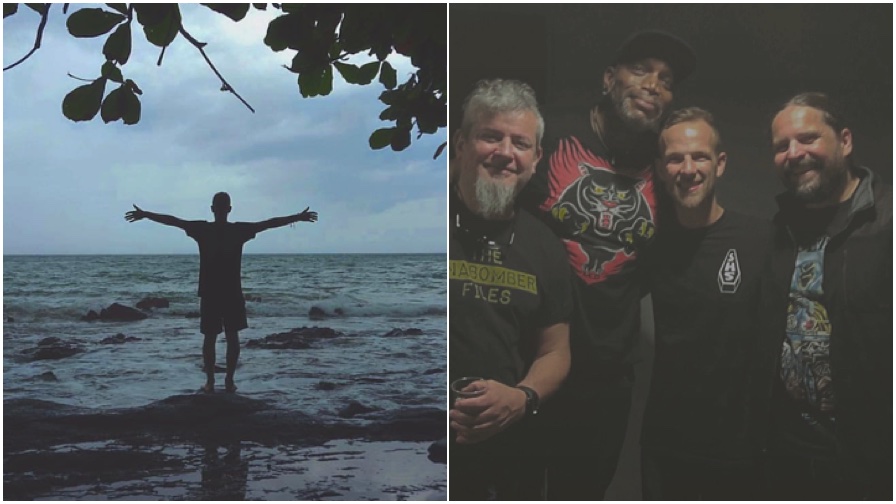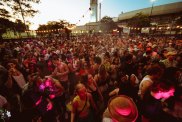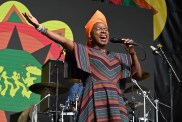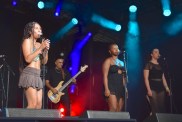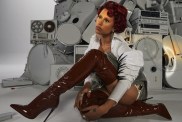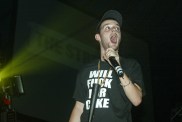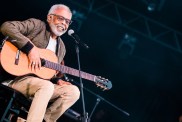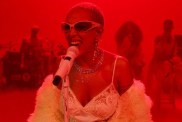10 years ago, David Owen Blackley was a 24-year-old metalhead grinding away full time as an assistant manager at the local Video Ezy in his hometown of Capalaba, about 20 kilometres south-east of Brisbane. Today, he’s a world-class music videographer who regularly tours all over the globe working with the kind of bands that once graced the posters on his bedroom wall.
From shooting Thy Art Is Murder film clips in Brisbane, to filming tour docos with Norma Jean in France, from bunkering down in Swedish studios with Sepultura to editing music videos he shot with bands like Alpha Wolf and Unearth from the tranquility of a Thai bungalow, David’s career over the past decade has been filled with the kind of adventures, experiences and opportunities that most creatives only ever daydream about.
In fact, David started out as one of those very creatives, working the cursed 9 to 5 slog while daydreaming about one day turning his passion into a fully-fledged career. But all that changed after one blood-curdling moment that brought him face to face with his own mortality.
“One night in 2011, while working by myself, I was involved in an armed robbery,” Dave tells Music Feeds.
“There was a moment where I was on my knees, in front of a safe I couldn’t open, with a sawed-off shotgun to the back of my head and I thought “What if?” …what would be my biggest regret at that point in time. That week I quit my job and went full-time with [my business] Her Name Is Murder Productions.”
Another huge leap of faith came a few years later in 2014, when David made another terrifying decision; to expand his business overseas.
“Between 2009 and 2014 I had shot and directed over 200 music videos and I was lucky enough to explore so much of Australia,” he reflects. “I had made many amazing new connections and friendships and had convinced myself I could use my work to see more of the world.
“So I packed up my place in Brisbane, sold or gave away nearly everything I had and, with my laptop, camera and some clothes, off I went.”
This led to another defining moment for David; stumbling across a little recording studio called Tpot, nestled in the Scottish hills.
The videographer’s decision to relocate there in 2015 and open up an office led to what he describes as “some of the most profound, emotional and defining, character-building moments in my life, both professionally and personally”.
“I fell in love with Scotland — the land, the people and the music,” David says. “Tpot saved me at a time when I thought about giving up and heading back to Australia. It holds a very special place in my heart and is the reason HNIMP began venturing into the world of music documentary. Tpot changed the trajectory of the business and, I am not kidding, my soul.”
This month, the entrepreneur marks the 10 year anniversary of his business baby, Her Name Is Murder Productions. It’s a huge milestone, which he says represents “a decade of connections, love and creativity, continued personal and professional growth, believing in myself and never giving up”.
“The business naturally became very personal to me,” David explains, “My back catalogue acts as a photo album and is a very intimate reflection of the last 10 years of my life.”
Now I’m going to break the 4th wall here and say I’ve had the pleasure of working with Dave on multiple occasions over the years, both in my band RedHook and other projects, and his endless passion, resilience, kind nature, sense of humour and creative spirit are a constant source of inspiration for many. It brings me great joy to share his story with you guys — as you can imagine 10 years worth of touring all over the world with sweaty, A-league metal bands has yielded some pretty wild tales!
So in honour of HNIMP’s 10th birthday, here’s a brief look back at some of the highs and lows of David’s nomadic musical adventures across the globe over the past decade (and the videos to prove it, of course).
Pictured: Brothers David & Dean Blackley at HNIMP’s 10 year anniversary celebration in Sydney / Credit: Kim Quint
Music Feeds: What was the first music video you ever shot and what do you remember about the experience?
David Owen Blackley: Ha, technically the first music video I ever shot was for The Amity Affliction. I think it was in 2004 for their track ‘A Sleepless Winter’. They had just released a three track demo / EP and Joel wasn’t in the band yet; they were a four-piece fronted by Ahren. It was actually for university assessment (I graduated from the Griffith Southbank College of Arts) and the director knew of the guys in TAA through a mutual friend. We shot the music video on 16mm and it turned out very rough around the edges. Out of the 2 rolls of film, we lost one due to light damage and we had little set or shooting experience. The guys talk about it on their DVD Seems Like Forever and it’s something I think we can all laugh about. Have to start somewhere! Fun fact – the video starred Big Brother/radio personality Michael Beveridge.
MF: What was the most bizarre music project you’ve ever worked on?
DOB: I had a shoot booked in with a really cool band from the Netherlands called Mary Fields. I was really excited to work these guys and we had a location organised for band performance video. There was a very cool rotunda in a park with some unique lighting and a cityscape backdrop, so we locked in a night to shoot for a few hours. After getting though a few full band takes, a man appeared from the darkness wearing a balaclava. He was obviously speaking in Dutch (a language I am learning, but not fluent in) but I could quickly tell the situation was extremely hostile. He shouted to us that if we didn’t stop the noise he would return with a gun and kill us. He then left, knocking down some lights. The band called the police, but we had no idea where he came from or where he went as we we surrounded by darkness. The police arrived and we gave our statements and, of course, the shoot was shut down. We were left with a music video that definitely needed more band performance footage… and luckily we found a second location and got what we needed at a later date!
MF: What would you say has been your most “dream come true” experience so far?
DOB: I’m at this really crazy point in time with HNIMP where I get to work with bands I listened to in high school, bands responsible for really shaping my love and interest in music and having a profound impact on me while growing up. I would go to the corner store and buy poster magazines like Kerrang! or Circus and line my bedroom walls with their posters. I’d play air guitar by myself, putting on imaginary concerts while blasting my favourite albums in the lounge room. To now work with some of these bands is a dream come true and beyond that, having these guys love what I do or mention to me that I’ve made some of the work they are most proud of or videos that are the truest representation of them means so much.
MF: This is a tough one, but which, of all your projects, are you most proud of and why?
DOB: Every time I update my showreel haha! It’s not until I get around to doing this every couple of years that I finally have a moment to really see the back catalogue and gain some retrospect. That little “best of” snippet brings on a flood of nostalgia and really puts in front of me the connections I’ve made around the world with people and places. I’m proud of it all because it’s all led to where I am right now talking to you, celebrating 10 years. Without any of those people, without any of those releases none of this would be possible.
https://vimeo.com/249098498
MF: What would you say was the worst thing that ever went wrong on a shoot and how did you overcome it?
DOB: A few years back I applied for press at a Belgium festival called Groezrock. I had never handled official interviews before or done anything close to that but I thought it would be a good opportunity to meet some international bands and network face to face. I implied I was a music journalist and was off to Belgium. I asked a few friends who were in this line of work for some advice and tried to line up interviews with bands I either loved or had some sort of knowledge of. The press I was approved for was broken up over two days and day 1 went really well. It was actually out of this that I met Trevor from Unearth and years later I shot a music video for those guys, thanks to this interview and first impressions!
But Day 2 came around, I felt in the swing of things, and before I knew it I was up to my lucky last – Frenzal Rhomb. One of my best mates had warned me about how their interviews tend to end up skew-whiff but I was feeling pretty confident. Within seconds they made me realise I had no idea what I was doing and my formula that had worked over the last 2 days instantly fell apart. They operated on another level and all of my questions fell flat and I froze. It were as if they called my bluff and started tearing me to shreds. I tried wrapping up the interview because I completely lost confidence but for some reason the guys didn’t want it to end and they decided to take over, now asking me questions. The whole thing flipped on its head and I just rolled with it while secretly shitting my pants. But the whole thing turned into a decent laugh and the interview rolled on. One dick flash to the camera later and it was officially over. I was left standing in the setting dust that was just Frenzal Rhomb, thinking what the hell happened, but feeling pretty good about it all.
MF: What would you say has been your most profound experience working on a project?
DOB: The first time I arrived at Tpot Studio, I had nothing to my name. I’d recently moved overseas where I spent the first 5 months living in London. That all fell apart pretty quickly. I had no film work coming in and my savings dwindled away on rent and the cost of living in a capital city. I found Tpot on a workaday site (where you trade service for food and shelter). I went out into the hills with my camera, and from the moment I arrived, I knew I was somewhere special. Everything about it was the complete opposite to London (what that city did teach me was what I wanted, and what I didn’t).
A pipe player by the name of Ross Ainslie was at Tpot recording his new album for the entire week I arrived. Between his extensive session band, producer and workaways, there were a dozen of us all living and breathing together in the middle of nowhere. When you record at Tpot, you live at the studio. There are no opening or closing hours. You sleep there, you eat together and you “insert blank here” together. You become a tribe. There’s no phone reception either so you really get lost in the experience of creating with no distraction from the “outside” world. I took out my camera and filmed the entire week. At the end of it all I had so much footage that I didn’t even know where to start. I just began putting it all together to try and explain what I saw and was feeling, and this is how I stumbled into making music documentaries.
One night after a great day of tracking, everyone decided to stop working and have a jam. I remember sitting in the room chatting with someone, and at first the acoustic guitar started and then, one by one, someone would enter the room and join in; flute, bagpipes, percussion etc. Before I knew it, the room was full with everyone playing their instruments and vibing with each other. My camera was sitting next to me but I wasn’t compelled to film. I decided this was a moment just for me. I sat there, cross-legged on the couch and lost for words, with the view of sheep and rolling hills through the windows of the room, creaking floor boards, rich with history beneath our feet, and I started crying because I realised a moment like this would be near impossible to explain to someone, and I suddenly realised how big the world was, and within it, I was experiencing this specific moment at this exact time. Some of the guys jamming looked at me and smiled, and from that moment on I knew I was meant to be overseas and I wanted to share stories and feelings like this through documentary film making.
MF: What was the scariest experience you’ve ever had working on a project?
DOB: I’m definitely guilty of doing a lot of things “guerrilla”. I think that’s why I love shooting documentary. I get a rush from the “point and shoot” mentality and utilising what I have around me at the time and going with that. Particularly in Australia, it’s not so easy to get away with a lot of guerrilla shooting, but in the early years of the business I did a lot of things off the book. There was one shoot in particular where I had scouted a car park location underneath a business premises in Brisbane. I wanted to shoot there on a weekend and when I checked it out, I discovered all the buildings above the carpark were closed on a Sunday. This was enough for me to decide I could get away with shooting a small narrative scene there. There was no band performance so I figured we would be quiet and not attract any attention with a small cast and crew. The scene involved multiple bodyguard type figures in suits and sunglasses standing around a tortured man tied to a chair, covered in bruises and blood, while another actor was responsible for physically threatening and abusing this character.
When we arrived to the location on this particular weekend I noticed that one of the businesses was actually open. I had brought everyone here and quickly decided to go ahead with the scene. This was at a point in time where I had become a little cocky with guerrilla-style shooting and told myself everything would be fine. In and out. We set up the scene and it looked great. We were ready to shoot and I pulled the actor aside and remember saying “I love everything you do – I want your intensity but I need you to please deliver it with little to no volume so we don’t get kicked out”. He nodded and I stood behind my camera, hit record and called action.
What I love about [actor] Gene Banyard is that he goes all in and always brings it; %110 every take. As soon as I called “action”, he walked into frame towards the actor tied to the chair … and then all hell broke lose. Gene is true method and he started yelling, cursing, spitting; literally going crazy and delivering a performance any director could only hope for! ….But it was not a silent performance.
The underground carpark’s side wall was designed with an open space above it where you could see a pedestrian bridge running to the entrance of the building that was open, and I spotted an elderly man standing on the bridge and looking down into the carpark. Before he ran back into the building, I managed to see the look on his face and instantly knew we were in trouble. I kept filming to get the scene and within 2 minutes three police cars screamed into the car park. The officers jumped out of their cars with their hands on their hips and I instantly threw my arms up, with camera in hand, so they didn’t mistake it from that distance as a gun. I could only imagine what the man thought he saw – multiple bulky guys in suits and sunglasses, a guy beaten and bruised, tied to a chair, and the amazing Gene — huffing and puffing with a hammer in his hand.
My saving grace was the fact that I could show them the footage of the scene as I explained to them I was a clueless film maker and thought it was public property.
MF: Was there a project that seemed like an insurmountable challenge, only for you to pull it off and end up stoked on the result?
DOB: When it came time to do the first music video with RedHook I was living in a bungalow on a small Thai Island called Koh Jum. I’m lucky enough to freelance some amazing film makers if I myself cannot be in Australia and when the time came to start organising ‘Minute On Fire’ with the guys, we planned out the concept and I was to be transferred the footage to later edit. When the guys were offered a great opportunity to premiere the video, the post-production deadline suddenly jumped forward considerably and fell into place while I was still living on this 10km long island, one hour from the mainland. The wifi there was almost non existent (storms would often hit and cut the power to the entire island!) so there was no way I’d be able to download all the footage. With the small window of opportunity we had for post-production I couldn’t believe that our best option would be for the guys to express post the external hard drive with all the footage to the island.
In just under a week, the external made it to the island and I worked on the edit with little sleep for the next few days. When the music video made the deadline and premiered I was really proud of everyone’s hustle. We came together and made it happen in such an extreme circumstance. That’s one of the thing I really love about my job; behind-the-scene stories such as this. So much goes into what anyone does that most people don’t know the half of it. It really puts things into perspective. The lengths we, as people, go to to in order to make things happen, to make things work out. Since then I have been involved with RedHook with every video release and it’s always memorable and one of my favourite creative (and personal) adventures!
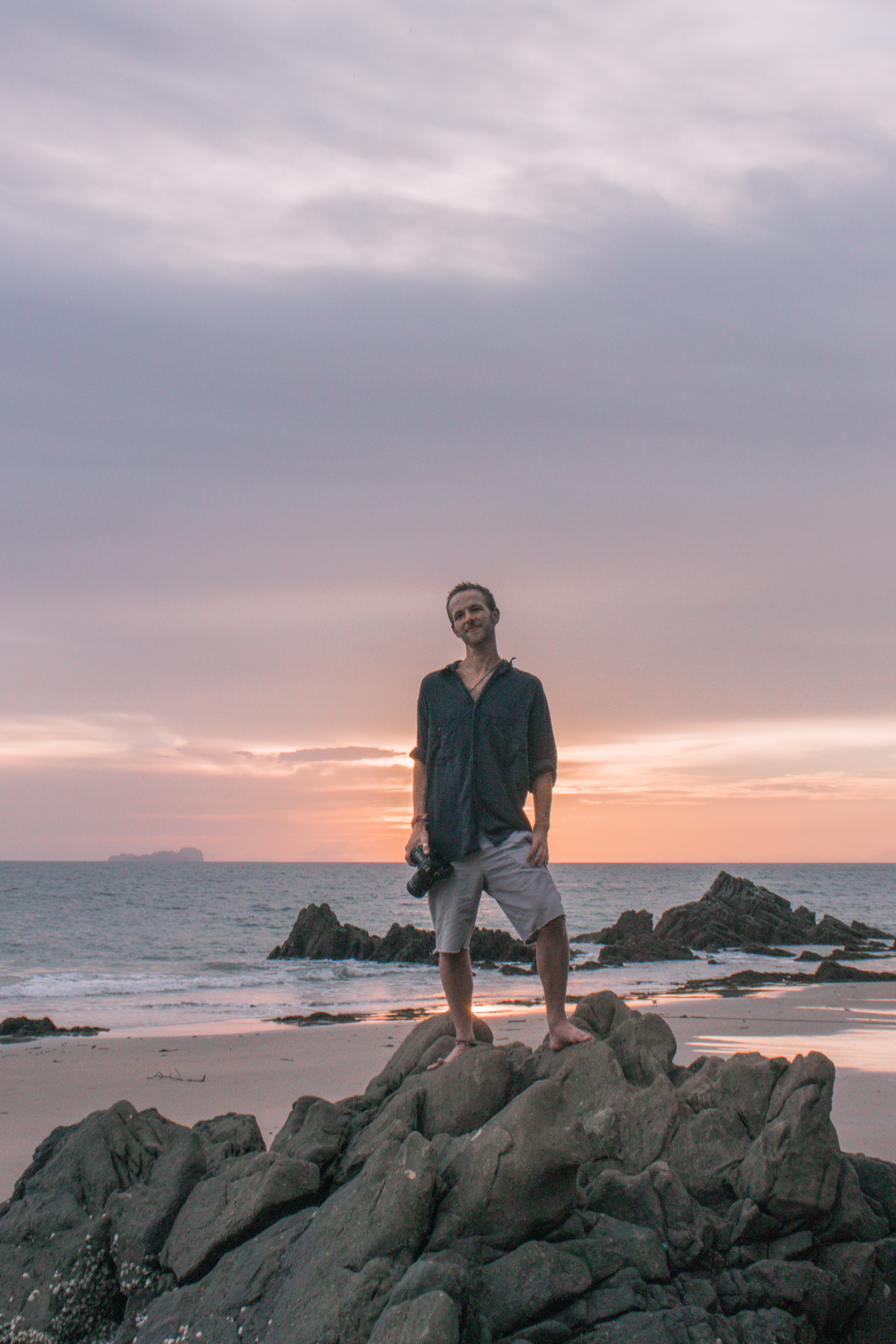
Credit: Chris Lisa Liefting
MF: Which project was one of the most fun?
DOB: I love touring! In many European countries, independent bands will do what’s called a Squat tour. Essentially these take place in broken down / abandoned / repossessed buildings where a small community have moved in and pay rent. A stage is set up, along with a bar and kitchen, and just like that, you have a live venue! Often with room to spend the night. I’ve done some two week runs with bands from Denmark throughout Europe and the shows and overall experiences were amazing. Bunker like rooms underground with one door in and out, or massive old-mansion sized buildings with endless rooms, broken walls, shattered windows and horror movie like aesthetics. Some venues were in town, others were in the middle of nowhere. One place in Poland was converted from a public toilet block into a venue. Most of the time, you would stay the night at the venue after the show and party with the people who attended and ran the place, and in the morning they would provide you with breakfast and then, like any other tour, you’d be back in the van and on to the next country / show.
I was documenting some blackened hardcore bands on these various tours and the passion of the fans was mesmerising. The connection between band and patron was intense and the people at the shows often looked like they were possessed or having out-of-body experiences. The rooms were small, sweaty, dark, grimy, cold. Loading in and out some of these places was testing because of access, or where the live room was located in the building, but the shows were always completely memorable and unique, so full on and worth it with so much energy.
One night in Warsaw we were all in our sleeping bags on the floor of an emptied-out hall and it was so cold I thought I was going to get pneumonia or something. Hours before this, we were all hanging out in various bedrooms with people from the community after the show, drinking and sharing stories. This was followed by watching Van Damme’s Bloodsport on a laptop while falling asleep to the sound of wind coming though broken windows, the creaking of floorboards and decrepit walls, muffled sounds of people continuing to party in the darkness of the night and JCVD’s fighting roar. I remember thinking how random things could be, and that I could never have imagined doing a tour like this, let alone having a life experience like this because I didn’t even know Squat tours were a thing. Luckily, I didn’t get pneumonia and when we woke up we were fed an amazing vego breakfast and back on our way to the next Squat venue.
MF: Can you tell us about a project that was life changing for you in some way?
DOB: I’ve been shooting on a Canon7D for nearly a decade and it wasn’t until September 2018 that my OG camera finally passed away. This camera had been with me since the beginning, seen me through highs and lows, provided me companionship when alone around the world and given me a voice as a visual storyteller. It wasn’t until after the shoot that I had a moment to let sink in what actually happened. I lost a friend; someone that really knew me and was there every step of the way.
My fiancee found me standing in the backyard and when I turned towards her she saw my face and knew. I gave her a big hug and mourned. I lost a part of me and needed to grieve. My camera knew and saw things no else had, especially in the early years overseas. Nights sleeping on bus stops around the world, crying because I sometimes felt so lost and alone, leaving a place and not knowing where I was going to sleep next or if I would have enough money for food. I made it through all this, with my camera always by my side and over the decade I designed the VintageHD aesthetic. I still shoot with a 7D and at this point in time couldn’t imagine it any other way.
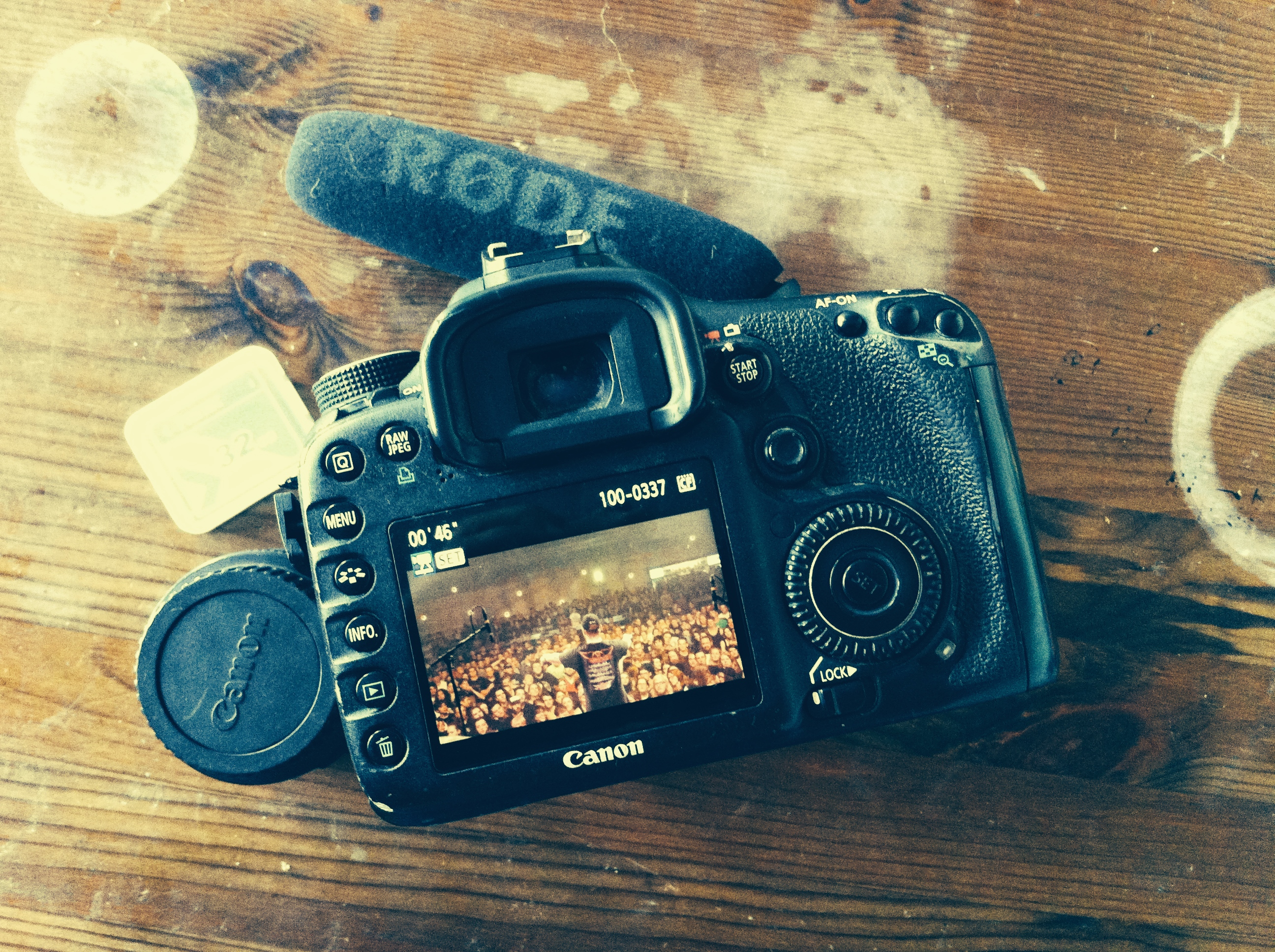
Credit: Chris Lisa Liefting
MF: Any other major highlights of the past 10 years you’d like to mention?
DOB: Here’s four that spring to mind:
- Blue Child Collective – ‘Building The Boat, Sailing The Seas’
Daniel White from Blue Child Collective was in a band called 10past6 and those guys were the first to bring me over to the west coast of Australia back in the day. I remember thinking what a big deal that was to me at the time and how it was a stepping stone towards “making it”. And that seemed to set the pace for Dan and I’s relationship. He later formed Blue Child Collective and not long before I left London I received a message from him asking me if I would be interested joining him in Corsica to document his summer there with BCC. I had no idea where Corsica was and after checking Google I instantly said “See you there!”.
I spent two European summers on the French Mediterranean island, living with a small community of glorious people and sleeping for 3 month in a hammock under the stars. One of those months was spent in the mountains living in a beautiful studio (Studio L’Angelina) that rested in a small hinterland village while he made his album “Saturn Saw The Seaside”. Those summers were some of the best times of my life. Dan has been a great friend and he really invested in HNIMP and believed in my work and vision. We’ve shared so much together and he alone provided me with many wonderful opportunities and experiences around the globe that I hold very close to my heart. It was a huge part in shaping my nomadic approach to directing and life on the road.
- Sworn In – ‘All Smiles’Documentary
I have a playlist on my phone that I jog to nearly everyday compiled of bands I want to work with and I use this as a way to manifest my ideas and apparitions. Sworn In announced a European tour nearly 6 months in advance and as they were one of my favourite bands I put together a proposal and messaged management. They told me to check back in closer to the date as it was too far away to commit to anything so each day I ran, listening only to Sworn In, until the job was confirmed.
Jumping into an already running tour and the crazy bubble of a world in which it exists is one thing, but every person is different and moods alter with every passing day, so you have no idea what you’re stepping into. In that short period of time you have to be someone people hopefully relate to, trust, connect with and open up to. And you can’t force that; it has to be authentic otherwise people will call the bluff. And on top of this, a story is potentially there to be told. A truth. A moment in time to be captured. In this circumstance I had 6 hours to work with the guys.
It’s the most demanding part of the job. To be a “guy” that becomes all these things and more, especially when for the most part it’s not a big part of your personality, but it is there somewhere and needed in order to tell the right story in the right moment. The beauty of a documentary is how honest they can be in capturing that moment in time. Outsiders have the opportunity to see the inside through visual mediums. They answer the questions and sometimes even give you more than you expect.
- RedHook – ‘Only Bones’
Sometimes when you work with bands you’re there from the beginning or the very early stages of their career. As they grow and start achieving various levels of success I can’t help but feel like a proud parent. It brings me so much happiness to see good people, good friends, kicking ass with what they love and seeing that connecting with people. To tour the UK and Europe this year with RedHook was something very special and to be there with them at Download UK was surreal. I’m so proud of the guys and excited for what the future will bring. I feel really humbled to play any part, big or small, in any band’s journey.
- Sepultura – Various
I’ve been lucky enough to work with Sepultura on various projects. Those guys, along with Pantera and Metallica, were the reason I started listening to heavy music in the late 90’s. In 2016, while tucked away in a countryside studio in Sweden, I documented the making of their album Machine Messiah at Fascination Street Studio with producer Jens Bogren. I’m really proud of these videos and the experience of living with the guys in close quarters for 6 weeks. I was invited back this year to once again document the band and the recording of their upcoming album, Quadra. I was so happy to be back at the same studio with Jens and the guys. It’s a peaceful, beautiful part of the world and I’m very humbled they wanted me there again to do what I do. Those guys mean a lot to me and I really value the friendships we have made together over the years.
MF: Finally, what’s next in the pipeline for HNIMP and where would you like to see yourself ten years from now?
DOB: HNIMP recently had a music video with Unearth premiere and I wrapped my final shoot of the year with our friends in Our Last Enemy back in Australia after the 10 year anniversary event. They were one of the first Sydney bands I ever worked with back in the beginning of the business; my brother and I have collaborated with the guys on all their releases. So for the Blackley Brothers to close out the decade shooting with them really felt like a “coming full circle” moment.
I’m now back in Europe where I’ll use the winter to my advantage; hibernate after a big year and enter a 2 month post-production bender! HNIMP have music videos and documentaries coming out for Sepultura’s upcoming album Quadra, releases with Will Haven, Lotus Eater, Pete Murray, RedHook etc and then I’ll be back into it come 2020 and ready to start the next decade!
I’d really like to take this opportunity to thank everyone involved with this journey. Whether you know it or not, it’s all been so important to HNIMP and myself and I truly feel so much love and gratitude because of it. Celebrating this anniversary is just as much a celebration of all your involvement and support. The fact that people have trusted me with their art over the years is something I don’t take lightly and I am truly honoured by that. I’m so proud of the things we have shared and created and I wouldn’t be here without that.
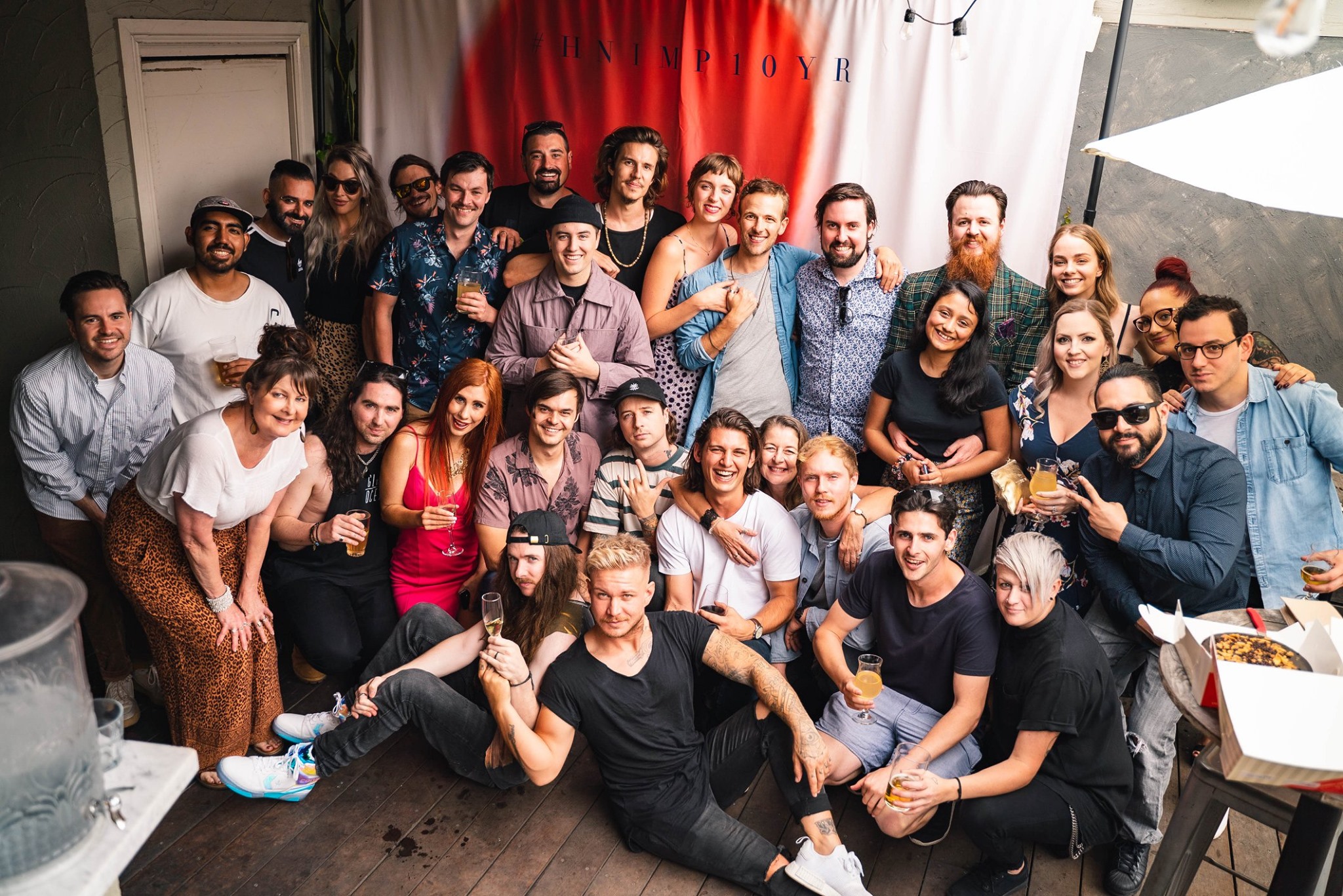
Pictured: HNIMP 10 Year Anniversary celebration in Sydney / Credit: Kim Quint
